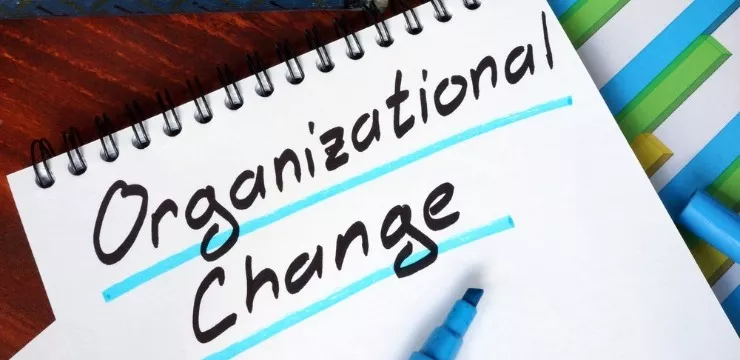
What is OCM?
OCM is short for organizational change management.
Below, we will explore OCM in detail, including:
- What OCM is
- How it works
- And why it is so necessary for changing businesses
Let’s start with the basics.
What Is OCM?
Organizational change management (OCM) keeps organizational change projects running smoothly.
Change managers and their teams hold a few responsibilities regarding organizational changes.
Organizational change management departments:
- Assess and minimize the risk of organizational change projects
- Ensure that change initiatives meet their goals within the intended timeframe and budget
- Improve project outcomes while reducing negative impacts to the business
- Overcome, avoid, or mitigate barriers to organizational change
This management discipline – also called change management – tends to focus on people, rather than processes or tools.
The main reason for this is that people run organizations.
Without their support, organizational changes cannot succeed.
How OCM Works
Organizational change managers follow a school of thought that originated in the early part of the 1900s.
Kurt Lewin, among others, contributed a great deal to the ideas that eventually became known as change management.
Today, many change managers use models that are founded on group dynamics and psychology.
These models are aimed at helping:
- Engage employees
- Motivate them to change
- Explain the need for change
- Provide the skills and tools to change
- Pushing organizational change forward, one step at a time
- Reinforcing the change once a project is complete
Though there are different change models, or frameworks, many of them tend to focus on steps such as these.
Benefits of OCM
There are many reasons why OCM is necessary:
- Risk analysis, prevention, and mitigation. Every business investment carries risk, including organizational change. Effective management will assess risks, rewards, and roadblocks in advance. This will help reduce risks and negative impacts to the business.
- Cost reduction. Managed projects cost less than unmanaged projects. These cost reductions can come from many directions – improved employee support, more efficient use of resources, and so forth.
- Reducing negative effects of change. Employee resistance and change fatigue, for instance, are two of the most common barriers to change (see below). An organizational change project can also impact many other areas of a business, however. One role of the change manager is to foresee, mitigate, and prevent these negative effects.
- Improved employee productivity, performance, and engagement. Employees drive every change project. With proper management and leadership, employees will be more productive and fuel a project’s success.
- Reduced chance of failure. Poor management, or lack of management, often results in failure. And failed projects can be very costly, which is yet another reason why change management is so important.
- Improvement of project outcomes. One of the goals of change management is to set goals … and exceed them when possible. The right change team will execute projects that meet those targets more often and get better results.
- Increased ROI of change projects. Better project outcomes translates into a higher return on investment.
If an organization doesn’t effectively manage change, then there is a very good chance the change project will lose money.
Or, in some cases, it could fizzle out entirely.
Barriers to Organizational Change
Organizational change has its fair share of obstacles, as does every business activity.
Some of the challenges to organizational change (which OCM helps to overcome) include:
- Change fatigue. Employees can tire of change projects, especially long ones. Change management uses specific tactics, such as reward systems or gamification, to prevent and mitigate this obstacle.
- Employee resistance. Workers often resist change for a variety of reasons. Common causes of resistance include fear of change, lack of time, lack of trust in leadership, and a lack of skills. As with the other obstacles mentioned here, change managers target these factors and create strategies to overcome them.
- Poor planning. Poor planning can also be the downfall of a change project. For instance, inexperienced business leaders may simply attempt to initiate a change by mandating it.
- Poor management. Likewise, when changes aren’t managed effectively, a variety of problems can crop up. Without proper management, the other problems mentioned here can easily spell the end of a change project.
- Budget constraints. Proper change management planning can help assess a project and ensure it stays within budget. Other times, foresight can help managers adjust a project’s trajectory or process to ensure that it is financially feasible.
- Lack of executive sponsorship. Executive support is a crucial factor for success in any change project. Change management teams should secure support as early as possible. Doing so can prevent roadblocks and ensure that the change project stays aligned with organizational objectives, among other things.
Change management principles are specifically geared to tackle barriers such as these.
This is one reason why change management is so valuable.
Unless managers consciously address such challenges, then there is a likelihood that their change projects could fail completely.
WalkMe Team
WalkMe spearheaded the Digital Adoption Platform (DAP) for associations to use the maximum capacity of their advanced resources. Utilizing man-made consciousness, AI, and context-oriented direction, WalkMe adds a powerful UI layer to raise the computerized proficiency, everything being equal.



